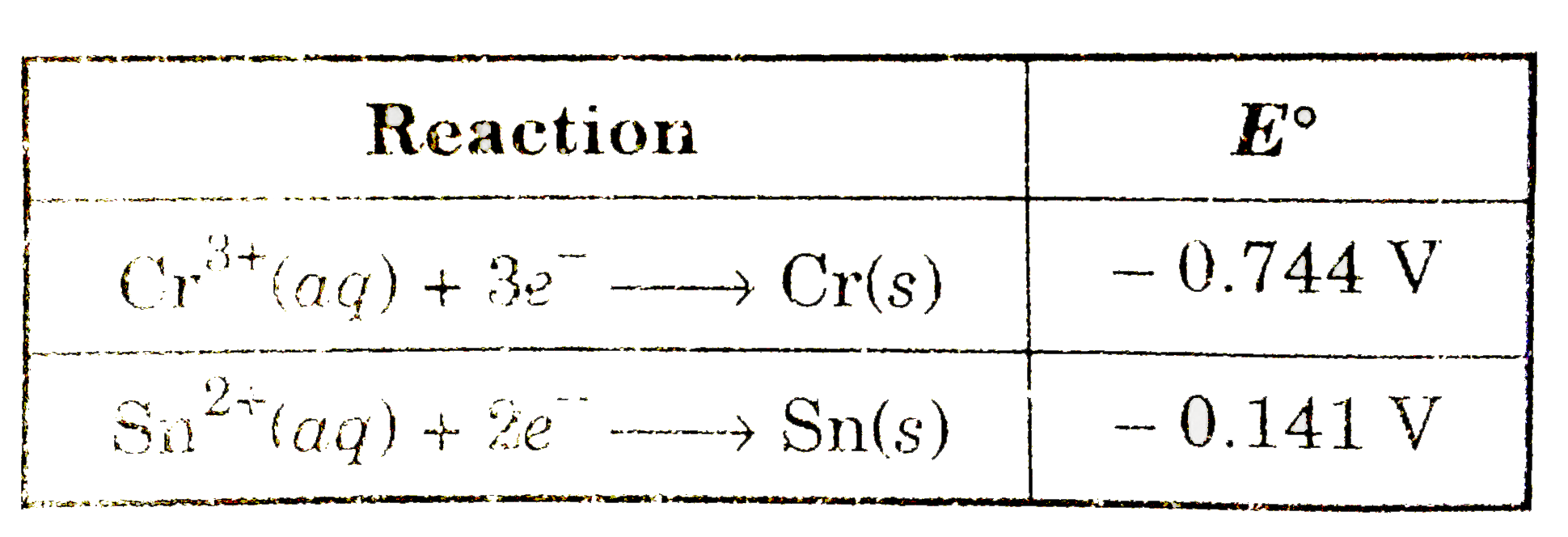The standard electrode potential for the reactions,
Ag+(aq)+e−→Ag(s)
Sn2+(aq)+2e−→Sn(s)
at 25∘C are 0.80 volt and −0.14 volt, respectively. The emfof the cell Sn∣∣Sn2+(1M)∣∣∣Ag+(1M)Ag is :
0.66 volt
0.80 volt
1.80 volt
0.94 volt
The correct Answer is:D
Step by step video, text & image solution for The standard electrode potential for the reactions, Ag^(+)(aq)+e^(-) rarr Ag(s) Sn^(2+)(aq)+2e^(-) rarr Sn(s) at 25^(@)C are 0.80 volt and -0.14 volt, respectively. The emfof the cell Sn|Sn^(2+)(1M)||Ag^(+)(1M)Ag is : by Chemistry experts to help you in doubts & scoring excellent marks in Class 12 exams.
Topper's Solved these Questions
- BOOK - GRB PUBLICATIONCHAPTER - ELECTROCHEMISTYEXERCISE - Batteries10videos
ELECTROCHEMISTY
- BOOK - GRB PUBLICATIONCHAPTER - ELECTROCHEMISTYEXERCISE - Thermodynamics in Electrochemistry22videos
ELECTROCHEMISTY
- BOOK - GRB PUBLICATIONCHAPTER - ELECTROCHEMISTYEXERCISE - Galvanic Cell and Salt Bridge85videos
ELECTROCHEMISTY
- BOOK - GRB PUBLICATIONCHAPTER - D-BLOCK ELEMENTSEXERCISE - Subjective Type18videos
D-BLOCK ELEMENTS
- BOOK - GRB PUBLICATIONCHAPTER - ENVIRONMENTAL CHEMISTRY EXERCISE - Straight objective type40videos
ENVIRONMENTAL CHEMISTRY
Similar Questions
Write short hand notation for the following reaction Sn2+(aq)+2Ag+(aq)→Sn4+(aq)+2Ag(s).
View SolutionConsider the reaction,
2Ag++Cd→2Ag+Cd2+
The standard electrode potentials for Ag+→Ag and Cd2+→Cd couples are 0.80 volt and -0.40 volt respectively.
(i) What is the standard potential E∘ for this reaction ?
(ii) For the electrochemical cell, in which this reaction takes place which electrode is negative electrode ?View Solution
Knowledge Check
- Question 1 - Select One
The standard electrode potentials for the reactions,
Ag+(a.q)+e−→Ag(s)
Sn2+(a.q)+2e−→Sn(s) at 25∘C are 0.80 volt and −0.14 volt respectively. The emf of the cell
Sn∣∣Sn2+(1M)∣∣∣∣Ag+(1M)∣∣Ag is:A0.66 voltB0.80 voltC1.08 voltD0.94 volt - Question 2 - Select One
The standard electrode potentials for the reactions
Ag+(aq)+e−→Ag(s)
Sn2+(aq)+2e−→Sn(s)
at 25∘C are 0.80 V and -0.14 V respectively The emf of the cell Sn∣∣Sn2+(1M)∣∣∣∣Ag+(1M)∣∣Ag isA0.48 VB0.80 VC1.08 VD0.94 v - Question 3 - Select One
The standard electrode potentials for the ractions
Ag+(aq)+e−→Ag(s)
sn+(aq)+2e−→Sn(s)
at 25∘C are 0.80 V and -0.14 V respectively the emf of the cell Sn∣∣Sn2+∣∣(1M)∣∣Ag+(1M)∣∣ Ag isA0.48 VB0.80 vC1.08 VD0.94 V
What is the standard cell potential for the reaction,
2Cr(s)+3Sn2+(aq)→3Sn(s)+2Cr3+(aq)
given the E∘ values shown?
 View Solution
View SolutionThe standard rectuion potentials for two half-cell reactions are given below
Cd2+(aq)+2e−→Cd(s),E∘=−0.40V
Ag+(aq)+e−→Ag(s),E∘=0.80V
The standard free energy change for the reaction
2Ag+(aq)+Cd(s)→2Ag(s)+Cd2+(aq) is given byView SolutionThe standard electrode potentials (reduction) of Pt/Fe3+,Fe+2 and Pt/Sn4+,Sn+2 are +0.77V and 0.15V respectively at 25∘C. The standard EMF of the reaction Sn4++2Fe2+→Sn2++2Fe3+ is
View SolutionEoRP for Fe+2/FeandSn+2/Sn electrodes are −0.75and−0.45 volt respectively. The standard emf for cell F+2+Sn→Sn+2+Fe is :
View SolutionUse the standard reduction potentials:
Sn2+(aq)+2e−→Sn(s) E∘=−0.141V
Ag+(aq)+e−→Ag(s) E∘=0.800V
To calcultate E∘ for the reaction:
Sn(s)+2Ag+(aq)→Sn2+(aq)+2Ag(s)View Solution

